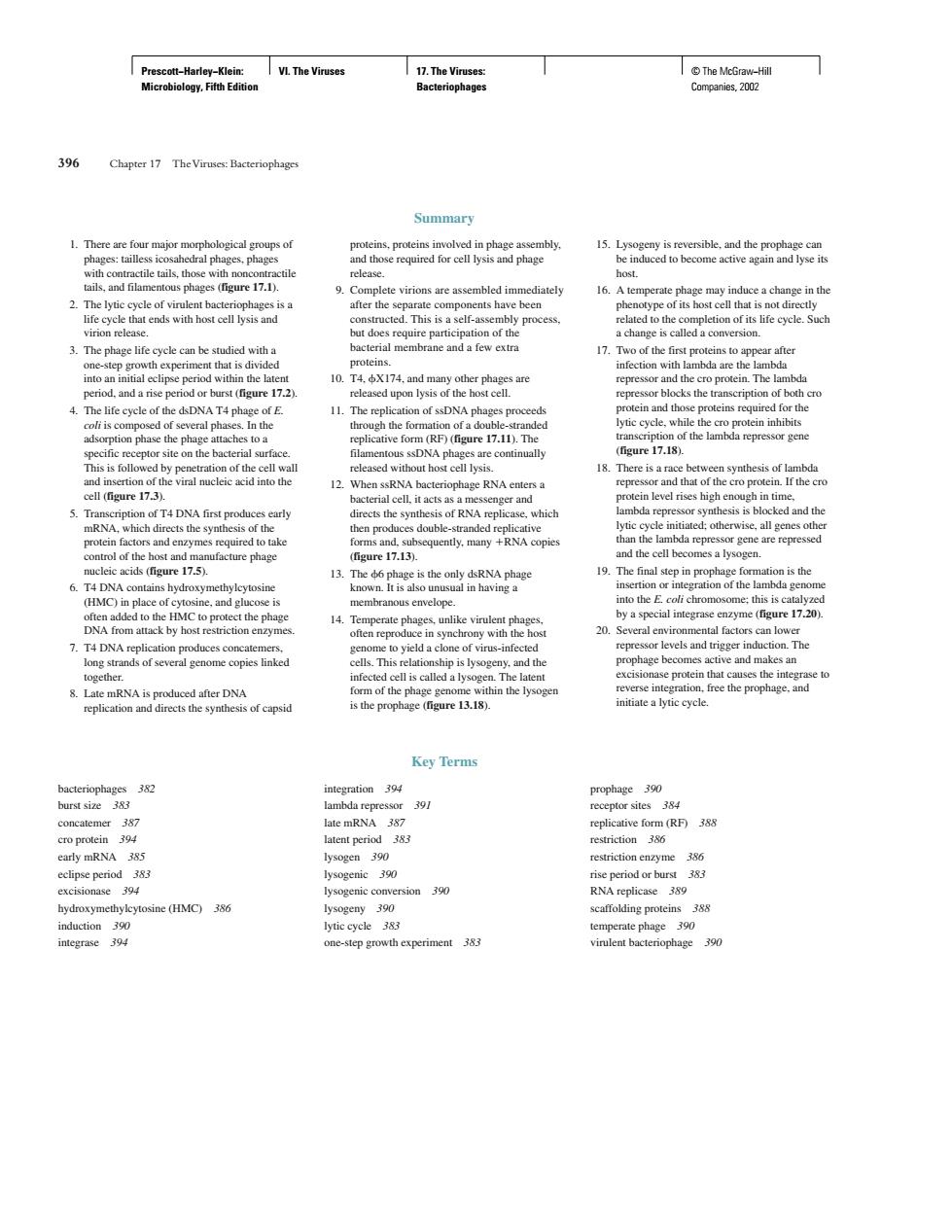正在加载图片...

96 Chapter 17 The Viruses:Bacteriophoage Summary n The lyti an be s 17. 2efpteiastopperac leasodwiho host c of T4 DNA first produe early hich dedan3t role ak s envelo DNA the 14.T of u s of capsid age (figure 13.1). KeyTerms 91 383 early mRNA 385 38 390Prescott−Harley−Klein: Microbiology, Fifth Edition VI. The Viruses 17. The Viruses: Bacteriophages © The McGraw−Hill Companies, 2002 396 Chapter 17 The Viruses: Bacteriophages Summary 1. There are four major morphological groups of phages: tailless icosahedral phages, phages with contractile tails, those with noncontractile tails, and filamentous phages (figure 17.1). 2. The lytic cycle of virulent bacteriophages is a life cycle that ends with host cell lysis and virion release. 3. The phage life cycle can be studied with a one-step growth experiment that is divided into an initial eclipse period within the latent period, and a rise period or burst (figure 17.2). 4. The life cycle of the dsDNA T4 phage of E. coli is composed of several phases. In the adsorption phase the phage attaches to a specific receptor site on the bacterial surface. This is followed by penetration of the cell wall and insertion of the viral nucleic acid into the cell (figure 17.3). 5. Transcription of T4 DNA first produces early mRNA, which directs the synthesis of the protein factors and enzymes required to take control of the host and manufacture phage nucleic acids (figure 17.5). 6. T4 DNA contains hydroxymethylcytosine (HMC) in place of cytosine, and glucose is often added to the HMC to protect the phage DNA from attack by host restriction enzymes. 7. T4 DNA replication produces concatemers, long strands of several genome copies linked together. 8. Late mRNA is produced after DNA replication and directs the synthesis of capsid proteins, proteins involved in phage assembly, and those required for cell lysis and phage release. 9. Complete virions are assembled immediately after the separate components have been constructed. This is a self-assembly process, but does require participation of the bacterial membrane and a few extra proteins. 10. T4, X174, and many other phages are released upon lysis of the host cell. 11. The replication of ssDNA phages proceeds through the formation of a double-stranded replicative form (RF) (figure 17.11). The filamentous ssDNA phages are continually released without host cell lysis. 12. When ssRNA bacteriophage RNA enters a bacterial cell, it acts as a messenger and directs the synthesis of RNA replicase, which then produces double-stranded replicative forms and, subsequently, many RNA copies (figure 17.13). 13. The 6 phage is the only dsRNA phage known. It is also unusual in having a membranous envelope. 14. Temperate phages, unlike virulent phages, often reproduce in synchrony with the host genome to yield a clone of virus-infected cells. This relationship is lysogeny, and the infected cell is called a lysogen. The latent form of the phage genome within the lysogen is the prophage (figure 13.18). 15. Lysogeny is reversible, and the prophage can be induced to become active again and lyse its host. 16. A temperate phage may induce a change in the phenotype of its host cell that is not directly related to the completion of its life cycle. Such a change is called a conversion. 17. Two of the first proteins to appear after infection with lambda are the lambda repressor and the cro protein. The lambda repressor blocks the transcription of both cro protein and those proteins required for the lytic cycle, while the cro protein inhibits transcription of the lambda repressor gene (figure 17.18). 18. There is a race between synthesis of lambda repressor and that of the cro protein. If the cro protein level rises high enough in time, lambda repressor synthesis is blocked and the lytic cycle initiated; otherwise, all genes other than the lambda repressor gene are repressed and the cell becomes a lysogen. 19. The final step in prophage formation is the insertion or integration of the lambda genome into the E. coli chromosome; this is catalyzed by a special integrase enzyme (figure 17.20). 20. Several environmental factors can lower repressor levels and trigger induction. The prophage becomes active and makes an excisionase protein that causes the integrase to reverse integration, free the prophage, and initiate a lytic cycle. Key Terms bacteriophages 382 burst size 383 concatemer 387 cro protein 394 early mRNA 385 eclipse period 383 excisionase 394 hydroxymethylcytosine (HMC) 386 induction 390 integrase 394 integration 394 lambda repressor 391 late mRNA 387 latent period 383 lysogen 390 lysogenic 390 lysogenic conversion 390 lysogeny 390 lytic cycle 383 one-step growth experiment 383 prophage 390 receptor sites 384 replicative form (RF) 388 restriction 386 restriction enzyme 386 rise period or burst 383 RNA replicase 389 scaffolding proteins 388 temperate phage 390 virulent bacteriophage 390�